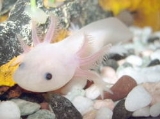
Axolotl
Overview
The axolotl Ambystoma mexicanum, is a neotenic
salamander
, closely related to the Tiger Salamander
. Larvae of this species fail to undergo metamorphosis
, so the adults remain aquatic and gilled
. It is also called ajolote (which is also a common name for different types of salamander
). The species originates from numerous lakes, such as Lake Xochimilco
underlying Mexico City
. Axolotls are used extensively in scientific research due to their ability to regenerate
limbs.
Axolotls should not be confused with waterdogs
, the larval stage of the closely related Tiger Salamanders (Ambystoma tigrinum and Ambystoma mavortium), which are widespread in much of North America and also occasionally become neotenic, nor with mudpuppies
(Necturus spp.), fully aquatic salamanders which are not closely related to the axolotl but bear a superficial resemblance.
, wild axolotls are near extinction due to urbanization in Mexico City and polluted waters.
Neoteny
Neoteny , also called juvenilization , is one of the two ways by which paedomorphism can arise. Paedomorphism is the retention by adults of traits previously seen only in juveniles, and is a subject studied in the field of developmental biology. In neoteny, the physiological development of an...
salamander
Salamander
Salamander is a common name of approximately 500 species of amphibians. They are typically characterized by a superficially lizard-like appearance, with their slender bodies, short noses, and long tails. All known fossils and extinct species fall under the order Caudata, while sometimes the extant...
, closely related to the Tiger Salamander
Tiger Salamander
The Tiger Salamander is a species of Mole Salamander. The proper common name is the Eastern Tiger Salamander, to differentiate from other closely related species.-Description:...
. Larvae of this species fail to undergo metamorphosis
Metamorphosis
Metamorphosis is a biological process by which an animal physically develops after birth or hatching, involving a conspicuous and relatively abrupt change in the animal's body structure through cell growth and differentiation...
, so the adults remain aquatic and gilled
External gills
External gills are the gills of an animal, most typically an amphibian, that are exposed to the environment, rather than set inside the pharynx and covered by gill slits, as they are in most fishes. Instead, the respiratory organs are set on a frill of stalks protruding from the sides of an animals...
. It is also called ajolote (which is also a common name for different types of salamander
Salamander
Salamander is a common name of approximately 500 species of amphibians. They are typically characterized by a superficially lizard-like appearance, with their slender bodies, short noses, and long tails. All known fossils and extinct species fall under the order Caudata, while sometimes the extant...
). The species originates from numerous lakes, such as Lake Xochimilco
Lake Xochimilco
Lake Xochimilco is an ancient endorheic lake located in the Valley of Mexico, part of a series of lakes, which included the brackish Lake Texcoco, Lake Zumpango, and Lake Xaltocan and the fresh water Lake Chalco...
underlying Mexico City
Mexico City
Mexico City is the Federal District , capital of Mexico and seat of the federal powers of the Mexican Union. It is a federal entity within Mexico which is not part of any one of the 31 Mexican states but belongs to the federation as a whole...
. Axolotls are used extensively in scientific research due to their ability to regenerate
Regeneration (biology)
In biology, regeneration is the process of renewal, restoration, and growth that makes genomes, cells, organs, organisms, and ecosystems resilient to natural fluctuations or events that cause disturbance or damage. Every species is capable of regeneration, from bacteria to humans. At its most...
limbs.
Axolotls should not be confused with waterdogs
Tiger Salamander
The Tiger Salamander is a species of Mole Salamander. The proper common name is the Eastern Tiger Salamander, to differentiate from other closely related species.-Description:...
, the larval stage of the closely related Tiger Salamanders (Ambystoma tigrinum and Ambystoma mavortium), which are widespread in much of North America and also occasionally become neotenic, nor with mudpuppies
Mudpuppy
Mudpuppies or waterdogs are aquatic salamanders of the family Proteidae. Their name originates from the misconception that they make a dog-like barking sound. The range of the genus Necturus runs from southern central Canada, through the midwestern United States, east to North Carolina and south to...
(Necturus spp.), fully aquatic salamanders which are not closely related to the axolotl but bear a superficial resemblance.
, wild axolotls are near extinction due to urbanization in Mexico City and polluted waters.
Unanswered Questions
Discussions

